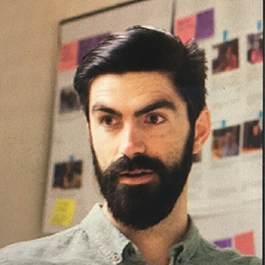Matt SwansonHuman-Centered Service Designer, UnitedHealth Group

Alumni Interview
"One thing that really surprised me when I got into healthcare was how cutting edge we were in design practice at EDI. I naively thought we were catching up to the industry, it turns out we were way out in front of the industry."
When you started EDI, did you know what industry you wanted to work in or were you still exploring?
When I started EDI I was looking for a compelling problem space with a variety of challenges that
Tell us about an EDI course that made an impact on you.
For me, there wasn't one individual course that made the impact. It was really about the progression of learning moments throughout the program and the consistent opportunity to just try something and succeed or fail that did it for me. For example, the time my team and I flipped our presentation on its head minutes before a client meeting and ad-libbed our delivery remains to this day among the best presentations I've ever given. Or the time our research plan fell apart in Guizhou China for Innovate for Impact helped me understand the limitations and risks of field research and how best to structure a project approach.
Is there anyone you worked with during EDI that you consider a mentor?
I look back at so many people who I considered a mentor during my time at EDI. It was more about everyone and the culture they created than one specific person or moment. Staff, faculty, and clients were all very open to discussing career, projects, design, design philosophy, anything. I also count many of my classmates as mentors during that time.
How did you decide on your EDI thesis project?
Hah! It was a struggle. At one point my thesis project was about decision making because I couldn't decide. I can find an interest in almost anything and the stakes felt very high for me at the time. Craig Sampson, my project mentor, and many others were very understanding and helped me move through scoping and project definition. My decision came when Craig came across an image of a medical device that we both knew was just designed terribly. It looked almost menacing and was very confusing, but had a great new piece of technology that could really make a difference. I sent an email to the doctor leading that project and the rest fell into place.
What advice do you have for an EDI student interested in working in your industry?
Embrace the ambiguity and time for experimentation. If you're a perfectionist, experiment with how it feels to let go. Projects in healthcare are never scoped as tightly as you wish they were and it's up to you to figure out how to make them work. So accept the client challenges as they're brought to you and find ways to work with the client in reframing and tightening scope. In the end, that's way better practice than asking them to give you a better-defined challenge. One thing that really surprised me when I got into healthcare was how cutting edge we were in design practice at EDI. I naively thought we were catching up to the industry, it turns out we were way out in front of the industry. A challenge you will have when you graduate is what I call the "Day One" challenge: you be spending a significant portion of your time educating and influencing others to believe in the value and power of design process (or the stuff you learned day one in your design coursework). It's a perpetual challenge that even the most experienced and talented leaders struggle to overcome. The more you can tie your experiments, successes, and failures back to fundamental values of design, the better off you'll be.

